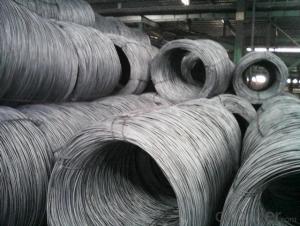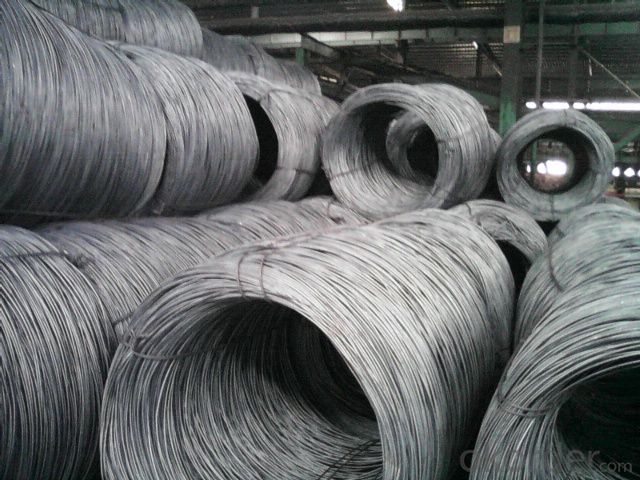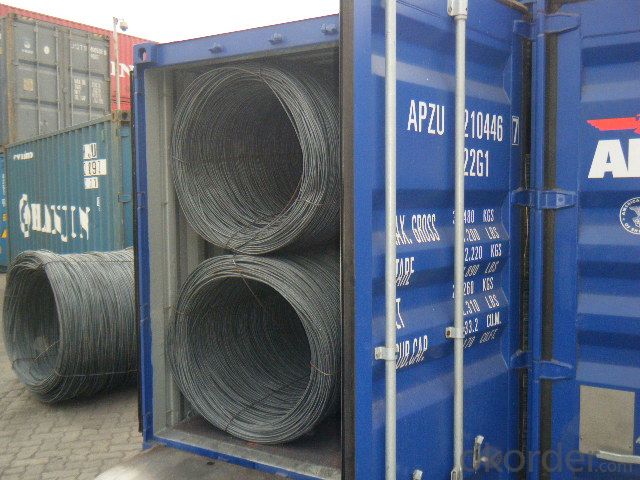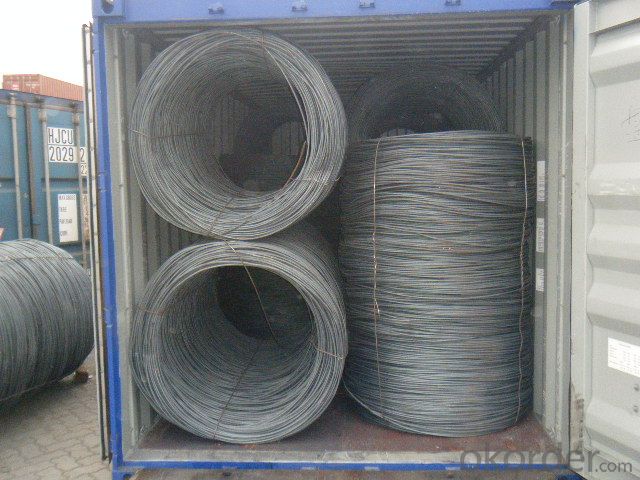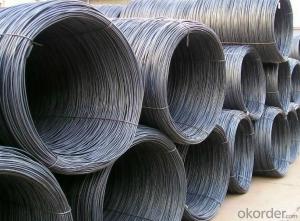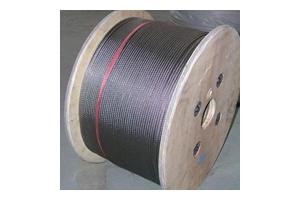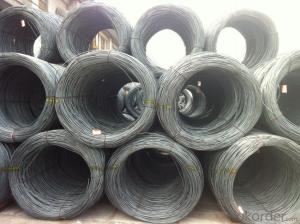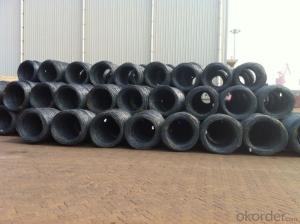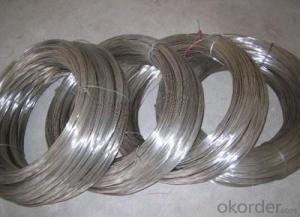Carbon Steel Wire Rod with High Quality for Construction
- Loading Port:
- China main port
- Payment Terms:
- TT or LC
- Min Order Qty:
- 20 m.t.
- Supply Capability:
- 10000 m.t./month
OKorder Service Pledge
OKorder Financial Service
You Might Also Like
Specifications of Carbon Steel Wire Rod with High Quality for Construction:
Steel Grade: Q195/235, SAE1006-1018B Standard: ASTM, GB
Diameter: 5.5mm, 6.5mm, 7mm,8mm,9mm,10mm,12mm,14mm
Diameter tolerance: ±0.3mm Type: in coil, coil weight around 2MT
Technique: Hot Rolled Place of Origin: China Mainland
Surface: round, no twisted, light and smooth Brand Name: HSKY
Chemical Composition: (Please kindly find our chemistry of our material based on Q195、Q235A and Q235B as below for your information)
Usage and Applications of Carbon Steel Wire Rod with High Quality for Construction:
After hot-rolled the products shaped into coil and delivery as finished product, including round, square, rectangular, hexagonal and so on. Since most of the products are round, it is generally called wire rod. Carbon steel wire rod is widely used in construction and manufacturing. Carbon steel wire rod is mainly used for reinforcement of reinforced concrete and welded structure or reprocessed (roberts , nail, etc.) materials, especially used to produce wire drawing, welding electrode, nails, spring, electronic, precise machinery parts and so on.
Packaging & Delivery of Carbon Steel Wire Rod with High Quality for Construction:
Packaging Detail: products are packed in coil, each coil weight around 2 MT, and then shipped by container or bulk vessel
Delivery Detail: within 45 days after received deposit or LC.
Label: to be specified by customer, generally, each bundle has 1-2 labels
Trade terms: FOB, CFR, CIF
FAQ:
Q1: How soon can we receive the product after purchase?
A1: Within three days of placing an order, we will begin production. The specific shipping date is dependent upon international and government factors, but is typically 7 to 10 workdays.
Q2: What makes stainless steel stainless?
A2: Stainless steel must contain at least 10.5 % chromium. It is this element that reacts with the oxygen in the air to form a complex chrome-oxide surface layer that is invisible but strong enough to prevent further oxygen from "staining" (rusting) the surface. Higher levels of chromium and the addition of other alloying elements such as nickel and molybdenum enhance this surface layer and improve the corrosion resistance of the stainless material.
Q3: Can stainless steel rust?
A3: Stainless does not "rust" as you think of regular steel rusting with a red oxide on the surface that flakes off. If you see red rust it is probably due to some iron particles that have contaminated the surface of the stainless steel and it is these iron particles that are rusting. Look at the source of the rusting and see if you can remove it from the surface.
Images:
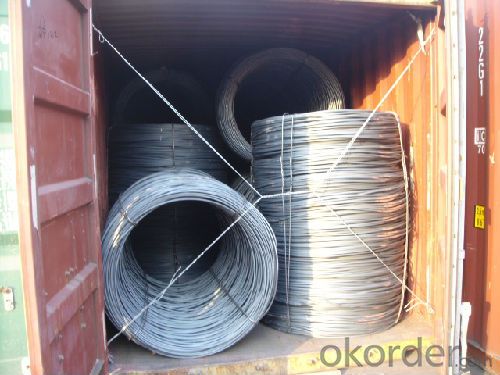

- Q: What are the safety standards for steel wire rod used in construction?
- The safety standards for steel wire rod used in construction are set to ensure the overall safety and structural integrity of buildings and structures. These standards are established by various regulatory bodies and organizations, such as the American Society for Testing and Materials (ASTM) and the International Organization for Standardization (ISO). One of the key safety standards for steel wire rod is its mechanical properties. This includes criteria such as its tensile strength, yield strength, and elongation, which determine the wire rod's ability to withstand loads and stresses. The wire rod must meet specific requirements for these properties to ensure it can perform its intended function safely. Another important safety standard is the quality control measures applied during the manufacturing process. Steel wire rod used in construction must go through rigorous testing and inspection procedures to ensure it meets the required standards. This includes checks for surface defects, dimensional accuracy, and chemical composition. In addition, the safety standards for steel wire rod also cover its corrosion resistance. Construction materials are often exposed to various environmental conditions, including moisture and chemicals, which can lead to corrosion. The wire rod must possess adequate corrosion resistance to ensure its long-term durability and structural stability. Furthermore, safety standards also address the packaging and transportation of steel wire rod. Proper packaging should be employed to prevent damage during transit and ensure safe handling. This includes using suitable protective materials and techniques to avoid any potential hazards during transportation. It is essential for construction companies and contractors to adhere to these safety standards when selecting and using steel wire rod in their projects. Compliance with these standards ensures the reliability and safety of the structures being built, protecting both workers and the general public. It is recommended to consult the relevant local codes and regulations, as well as industry-specific standards, when determining the safety standards for steel wire rod used in construction. Additionally, working with reputable suppliers and manufacturers who adhere to these standards can provide assurance of the quality and safety of the wire rod being used.
- Q: What are the common production processes for platinum-coated steel wire rod?
- The common production processes for platinum-coated steel wire rod typically involve wire drawing, cleaning, coating, and annealing. The steel wire rod is first drawn through a series of dies to reduce its diameter and improve its mechanical properties. Then, the wire is thoroughly cleaned to remove any impurities or contaminants. After cleaning, a thin layer of platinum is applied to the surface of the wire through a coating process, which can be electroplating or physical vapor deposition. Finally, the platinum-coated wire rod undergoes annealing, a heat treatment process that helps to enhance its strength, flexibility, and other desired properties.
- Q: How is steel wire rod used in the manufacturing of fencing?
- Steel wire rod is commonly used in the manufacturing of fencing as it provides strength and durability to the fencing structure. It is often used to make the vertical wires or pickets of the fence, which are then attached to horizontal wires or rails to form the fence panels. The steel wire rod is typically galvanized or coated to prevent corrosion and increase its lifespan. This allows the fencing to withstand harsh weather conditions and provide security and containment for various applications, such as residential, commercial, or agricultural purposes.
- Q: What are the main factors influencing the choice of steel wire rod order storage tracking options?
- There are several main factors that influence the choice of steel wire rod order storage tracking options. Firstly, the size and complexity of the storage facility play a significant role in determining the tracking options. If the facility is large and has multiple storage areas or racks, it becomes essential to have a comprehensive tracking system that can accurately locate and monitor each order of steel wire rod. Secondly, the frequency and volume of incoming and outgoing orders also impact the choice of tracking options. If the facility handles a high volume of orders on a regular basis, a real-time tracking system that provides instant updates on the status and location of each order becomes crucial for efficient operations. Thirdly, the level of automation in the storage facility is another factor to consider. If the facility is highly automated, with robotic systems handling the movement and storage of steel wire rod, the tracking options should integrate seamlessly with the automation system to ensure accurate and synchronized tracking of orders. Additionally, the specific requirements and preferences of the customers and suppliers can influence the choice of tracking options. Some customers may require real-time updates and visibility into the status of their orders, while others may prioritize cost-effectiveness or simplicity. Similarly, suppliers may have their own tracking systems in place, which need to be compatible with the storage facility's tracking options. Lastly, the overall budget allocated for implementing and maintaining the tracking system is an important consideration. More advanced tracking options, such as RFID or barcode systems, may require higher upfront investment and ongoing maintenance costs. Therefore, the financial resources available will impact the chosen tracking options. In conclusion, the choice of steel wire rod order storage tracking options is influenced by factors such as the size and complexity of the storage facility, the frequency and volume of orders, the level of automation, customer and supplier requirements, and budget constraints. By carefully considering these factors, an appropriate tracking system can be selected to streamline operations and enhance efficiency in managing steel wire rod orders.
- Q: How is steel wire rod tested for uniformity of diameter?
- Steel wire rod is tested for uniformity of diameter through a process called diameter measurement. This involves using high-precision instruments, such as micrometers or laser gauges, to measure the diameter at various points along the rod. These measurements are then compared to establish the degree of uniformity. Additionally, statistical analysis may be performed to determine the average diameter and the range of variation within the wire rod.
- Q: How is the steel wire rod market impacted by technological advancements?
- Technological advancements have significantly impacted the steel wire rod market by revolutionizing the manufacturing process, improving product quality, and enhancing operational efficiency. Advanced manufacturing techniques such as automation, robotics, and data analytics have streamlined production, leading to higher productivity and reduced costs. Furthermore, technological advancements in metallurgy and material science have resulted in the development of stronger and more durable wire rods, meeting the evolving demands of various industries. Additionally, innovations in wire rod coatings and surface treatments have expanded the range of applications and improved corrosion resistance. Overall, technological advancements have played a crucial role in shaping the steel wire rod market, driving growth, and enabling manufacturers to stay competitive in a rapidly changing industrial landscape.
- Q: How is the steel wire rod market affected by mergers and acquisitions?
- Mergers and acquisitions have a significant impact on the steel wire rod market. When companies in this industry merge or acquire each other, it results in consolidation within the market. This consolidation can have both positive and negative effects on the overall dynamics of the market. One of the main consequences of mergers and acquisitions in the steel wire rod market is a potential decrease in competition. When two or more companies merge, they combine their resources, production capabilities, and market share. This creates a larger and more dominant player in the industry, which can lead to reduced competition. As a result, the merged entity gains more control over pricing and market conditions. On the positive side, mergers and acquisitions can also generate economies of scale. By merging operations and streamlining processes, companies can achieve cost savings and improve efficiency. This, in turn, can lower production costs, potentially leading to lower prices for customers. Additionally, the merged entity may gain access to a wider customer base and distribution network, allowing them to reach new markets and increase their market share. However, there are also potential downsides to mergers and acquisitions in the steel wire rod market. Consolidation may result in job losses as duplicate positions are eliminated to achieve cost synergies. Moreover, if the merged entity becomes too dominant in the market, it may have the power to dictate terms to other market participants, potentially limiting choices and options for customers. Overall, the impact of mergers and acquisitions on the steel wire rod market depends on various factors, such as the size and scope of the merger, the market structure, and the competitive landscape. While consolidation can bring about positive and negative effects, it is crucial for regulators to monitor and ensure fair competition to protect consumer interests and maintain a healthy market environment.
- Q: How is steel wire rod used in the manufacturing of electrical conductors?
- Steel wire rod is used in the manufacturing of electrical conductors as it provides the necessary strength and flexibility required to transmit electricity efficiently. The wire rod is drawn into thin wires which are then insulated and used as the core of electrical cables. These conductors are widely used in power transmission lines, electrical wiring systems, and various electrical appliances to ensure the safe and reliable flow of electricity.
- Q: What are the different international specifications for steel wire rod?
- There are several international specifications for steel wire rod, including the ASTM (American Society for Testing and Materials) standards, the EN (European Norm) standards, and the JIS (Japanese Industrial Standards) standards. These specifications outline the requirements for various properties of steel wire rod, such as its chemical composition, mechanical properties, and dimensions. They ensure that steel wire rod produced and used globally meets specific quality and performance standards.
- Q: What are the typical mechanical properties of steel wire rod?
- The typical mechanical properties of steel wire rod include high tensile strength, good ductility, and excellent resistance to bending and stretching. It also exhibits low elasticity, making it suitable for applications that require high strength and durability.
Send your message to us
Carbon Steel Wire Rod with High Quality for Construction
- Loading Port:
- China main port
- Payment Terms:
- TT or LC
- Min Order Qty:
- 20 m.t.
- Supply Capability:
- 10000 m.t./month
OKorder Service Pledge
OKorder Financial Service
Similar products
Hot products
Hot Searches
Related keywords
